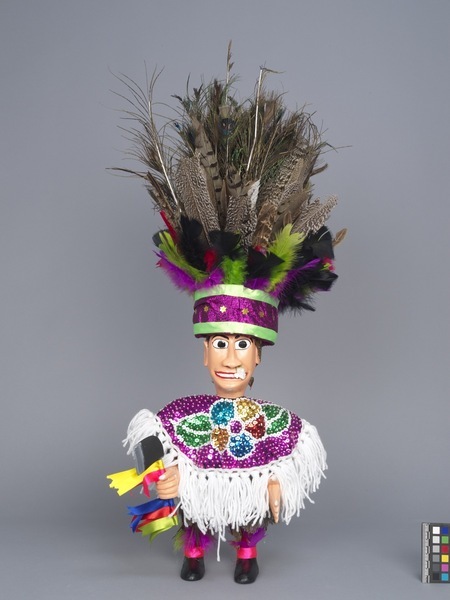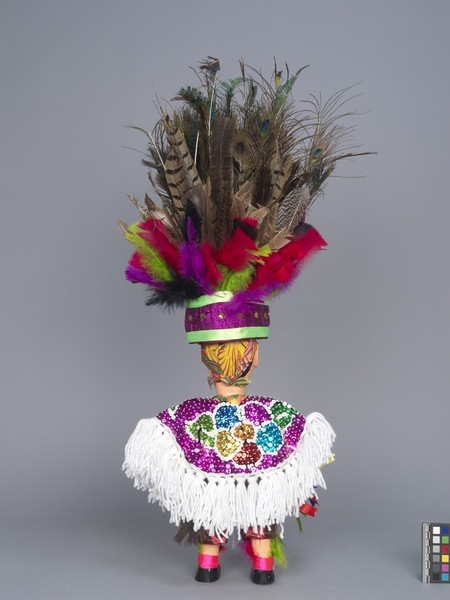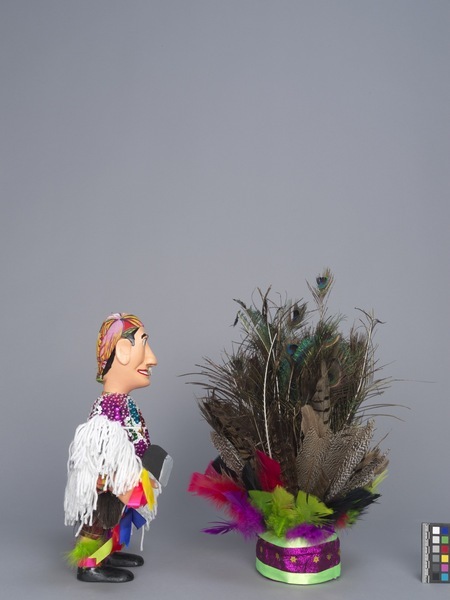Hand Puppet Item Number: 3381/19 a-b from the MOA: University of British Columbia




Description
Mamulengo hand puppet of a 'Caboclo de Pena' character (part a), with a large feather headdress (part b). Carved from wood and painted. He has light orange-beige skin, wide black eyes, small nose with large nostrils, and an open mouth with thin red lips. He holds a white flower in his mouth. He wears shiny red leggings with neon pink ribbon around the cuffs, with purple and neon green feathers tucked in the ribbon. He wears a speckled brown-grey feather skirt with a poncho overtop. The poncho is heavily sequined with a dark pink background and flower design in green, blue, gold, red, pink and bronze. Each sequin has a clear bead sewn at at centre. The poncho is lined with long white tassels. He wears a headdress (part b) with woven base wrapped in shiny dark pink fabric, decorated with gold star sequins around the centre and light green ribbon around the edges. Tall feathers extending up from the band, with brightly dyed feathers around the outer edge, and tall natural feathers at centre. He holds an axe in his right hand with various coloured ribbons wrapped around the staff down the entire length. His boots are painted black.
History Of Use
The puppet represents a character from a form of popular puppet theatre, found in northeastern Brazil, called mamulengo. This type of theatre is prevalent in disenfranchised communities with ancestral ties to colonized Indigenous peoples and uprooted, enslaved Africans. Mamulengo performances are entertaining events that can last all night long, with puppeteers (mamulengueiros) using 70 to 100 puppets in one staging. The stages are pop-up stands (empanadas), made of brightly coloured, floral-printed cloth. The shows consist of short sequences (passagens), or skits from popular stories that expose the inequalities and dramas of everyday life, profiling stock characters such as rich landowners and peasant labourers. The whole is spun together with humour, satire, lively music, and audience commentary.
Item History
- Made by Edjane Maria Ferreira de (Maker) in Gloria do Goita, Pernambuco, Brazil during 2018
- Owned by Associacao Cultural de Amigos do Museu de Folclore Edison Carneiro before July 25, 2019
- Received from Associacao Cultural de Amigos do Museu de Folclore Edison Carneiro (Seller) and Museum of Anthropology Exhibitions Budget (Funding source) on July 25, 2019
What
Who
- Culture
- Brazilian
- Creator
- Edjane Maria Ferreira de (Maker)
- Previous Owner
- Associacao Cultural de Amigos do Museu de Folclore Edison Carneiro
- Received from
- Associacao Cultural de Amigos do Museu de Folclore Edison Carneiro (Seller) and Museum of Anthropology Exhibitions Budget (Funding source)
Where
- Holding Institution
- MOA: University of British Columbia
- Made in
- Gloria do Goita, Pernambuco, Brazil
When
- Creation Date
- during 2018
- Ownership Date
- before July 25, 2019
- Acquisition Date
- on July 25, 2019
Other
- Condition
- good
- Accession Number
- 3381/0019